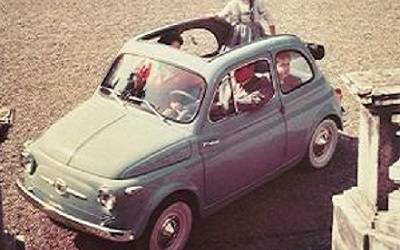Despite Fiat’s 1936 500 “Topolino” being a well-liked little car in its day, the Nuova 500 of 1957 is what the motoring world today perceives as the original 500.

Fiat Nuova 500 1957
- YEAR REVEALED 1957
- PLACE OF ORIGIN Turin, Italy
- HISTORICAL STATUS production car
- ENGINE two-cylinder, 29–36ci (479–594cc)
- MAXIMUM POWER 23bhp
- LAYOUT rear-mounted engine driving the rear wheels
- BODYWORK two-door, four-seater sedan and estate
- TOP SPEED 60mph (97kph)
- NUMBER BUILT 3,408,036
The first 500 had a tiny four-cylinder engine, water-cooled and front-mounted; this all-new one boasted a twin-cylinder, air-cooled powerpack at the back. Intended as utilitarian transportation for the masses, it was brought to the market by Fiat in response to an Italian government pledge to boost car ownership by investing heavily in Italy’s main road and highway network.
The man in charge of development was Fiat’s Dante Giacosa, also the genius behind the original 500 during a 50-year career with the company. The Nuova 500 was meant to get cash-strapped Italians off their scooters, but it still offered fresh air: until 1966 every 500 came with a full-length sunroof.
A toy-like four-seater with go-kart handling, the original cars were “powered” by a 29ci (479cc) twin offering a paltry 13bhp, mercifully lifted to 30ci (499cc) and 18bhp for the 500D in 1960 so it could cruise at 55mph (89kph). Buyers were just as sold on the 50mpg (18km/l) fuel economy. Early cars had rear-hinged “suicide” doors, but post-1965 500F models gained conventional front hinges. The 500L version of 1968 offered buyers luxury via the three simple additions of carpets, reclining seats, and chrome bumpers.